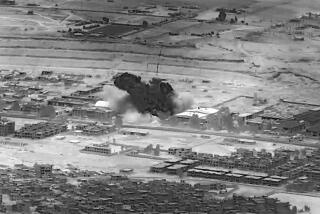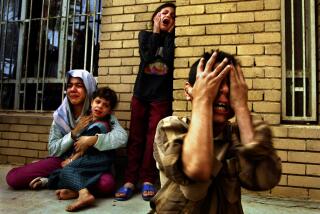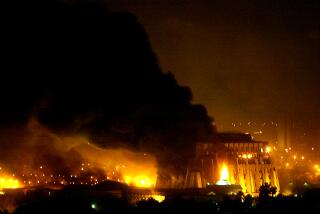No Place to Hide--Guard Pays the Price
- Share via
SOUTHEASTERN IRAQ — During the 16-hour battle, the arid Iraqi desert floor was thick with fire and thunder as U.S. tanks, artillery, attack helicopters and fixed-wing aircraft threw everything they had at Saddam Hussein’s Republican Guard.
And when his vaunted troops finally began a desperate but surprisingly hasty retreat toward Basra--with their remaining tanks loaded onto giant flatbed trucks--U.S. forces pursued them with a vengeance, picking off so many tanks that one pilot later called it a turkey-shoot.
Yet enough Republican Guard elements managed to run far enough toward Basra that they came under the protection of their own artillery fire.
The Iraqis also managed to shoot down a pursuing F-16 jet.
And when a U.S. Blackhawk helicopter swooped low on a search-and-rescue mission for the F-16 pilot, the Iraqis blew it to pieces, killing all eight Americans aboard in an acrid fireball that shattered the ink-black sky.
An accompanying Apache attack helicopter also was hit by enemy fire, but it managed to wobble back to a makeshift base in southwestern Iraq. The fate of the F-16 pilot was not immediately known.
By the time a merciful silence at last fell over the bleak terrain of southeastern Iraq early Thursday, most of the U.S. attack helicopters had charged so far ahead of their supply lines in the heat of battle that they were scattered at temporary allied bases throughout enemy territory, spent and without fuel.
“It was a classic tank-air battle, from the textbooks, a table-top battle,” said Army Col. Paul Murtha of the 18th Airborne Corps.
Even Baghdad Radio on Thursday referred to it as a “great showdown.”
The “mother of all battles” in this lopsided war began Wednesday afternoon, long after the Iraqis had high-tailed it out of Kuwait.
Pursued from the south by troops of the 28-nation anti-Iraq alliance, the two Republican Guard armored and mechanized divisions and an artillery battalion discovered belatedly that they were trapped.
To the west, they were outflanked by a solid wall of British and American forces, led by the 18th Airborne Corps, with its fast-moving airborne troops, armored cavalry and infantry divisions.
To the south was the menacing U.S. Army’s VII Corps, its armored and infantry divisions gaining steadily.
To the north, a great marshland stood in the way of a hasty retreat.
And so the Republican Guards wheeled toward the northeast, racing for Basra, their wartime staging area below the confluence of the Tigris and Euphrates rivers.
To reach Baghdad, they had to somehow ford the mud-brown Euphrates, whose bridges had all been bombed out during the massive allied air campaign.
But first they had to get there.
On their western flank, already braced for the mighty confrontation, the U.S. 24th Mechanized Infantry Division and the 101st and 82nd Airborne divisions took off after Hussein’s finest.
Secure in the knowledge that their left flank was guarded by the French 6th Armored Division, the Americans gained rapidly on the Republican Guard.
At one point, three battalions of the 24th overran and captured the Jalibah airfield in just 50 minutes, destroying 10 fighter jets, eight helicopters, two cargo planes and at least six antiaircraft guns. The warplanes destroyed included at least one Soviet-built MIG-29. It was from this airfield that numerous Iraqi jets had fled to Iran after the allied air war began.
When the lead elements of the 101st, known as the Screaming Eagles, reached Highway 8 near the Euphrates River, the final Iraqi escape route toward Baghdad was teeming with enemy armored personnel carriers, trucks, tanks and other heavy equipment--all lumbering northward.
“They were in full retreat, bumper to bumper,” said Brig. Gen. Henry Shelton, deputy commander of the 101st Airborne.
“They had nowhere to run,” he added. “And we didn’t leave them any place to hide.”
The Iraqis’ precious Soviet-made T-72 tanks sat defenseless, like overstuffed birds, on their flatbed trucks.
For the 18th Airborne--with its attack helicopters, light armor and armored cavalry units--it was target-practice time.
But the Iraqi’s let loose a last-gasp barrage of heavy antiaircraft fire that cost the lives of eight GIs on their mission to rescue the downed F-16 pilot.
Amid the heavy exchange, Iraqi engineers tried valiantly to erect a pontoon bridge across one of the waterways, a final barrier in the way of the Republican Guard’s retreat to its Basra headquarters.
But an Apache helicopter battalion put a stop to that.
By 6 a.m. Thursday, an eerie silence greeted the dawn of a new day in this cradle of civilization.
Scores of tanks and other Iraqi war vehicles lay smoldering across the landscape. Not one of them had reached Basra. Hundreds of Republican Guard members had been captured and hundreds more died.
This story was compiled from pool reports reviewed by military censors.
LAST BIG BATTLE
The last major battle of the war was fought in southeastern Iraq, west of the port city of Basra, where U.S. tanks, artillery, attack helicopters and fixed-wing aircraft hammered Republican Guard divisions trying to escape over the Euphrates River. The guns roared for 16 hours. Here’s how the battle went, according to pool reports: Dozens of U.S. Army attack helicopters chased two Republican Guard armored and mechanized divisions and an artillery battalion fleeing Kuwait. On the ground, U.S. armor was in hot pursuit.
The Iraqis, apparently aware they were outflanked to the west, faced advancing troops from the south and a great marshland to the north. They raced northeast to try to break out through Basra.
U.S. forces, on the western flank, made a sharp right at the Euphrates in pursuit of the Iraqis.
Many of the Iraqi tanks, placed on giant flatbed trucks to speed their journey, were easily taken out by air power. But some got far enough north to come under the protection of antiaircraft fire.
In the last hours, Iraqi engineers were still trying to build a pontoon bridge across waterways between them and Basra, but allied helicopters destroyed that final effort.
By 6 a.m. it was all over. Allied reports indicated that not a single Iraqi tank made it to Basra.
More to Read
Sign up for Essential California
The most important California stories and recommendations in your inbox every morning.
You may occasionally receive promotional content from the Los Angeles Times.













